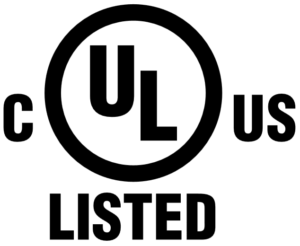Underwriters Laboratories, also known as UL, is an independent safety certification organization. Since 1984, they have been testing a wide variety of products, components and materials against specific standards to determine if they are safe to use. But what exactly is UL certification? And why is the UL seal so important, especially when selling electronic equipment?
UL seal: Why is it important?
Over the past century, Underwriters Laboratories has become the world’s most recognized independent product safety certification organization. Each year, millions of products and their components are tested to UL’s rigorous safety standards. This makes the UL seal especially important for products intended for use in the United States, where product liability laws are even stricter than in Europe.
UL tests ensure, for example, that devices can handle the specified amount of current. It also ensures that products are properly constructed and therefore safe to use.
Different kinds of UL seals
A general UL approval does not exist. Instead, it is divided into different stages:
UL Recognized
The UL Recognized test seal is often granted to components that are used in a product carrying a UL Listed seal, such as circuit boards or power supply units, for example.
UL Listed
The biggest difference between UL Recognized and UL Listed is that the latter is awarded to stand-alone products. To qualify for certification, the product undergoes far more testing than is required for a product to be UL Recognized.
 The UL Listed mark means that UL has tested the product against nationally recognized safety and sustainability standards. A UL Listed certification guarantees the safety and durability of many household products under normal wear and tear in everyday use, and is therefore considered a mark of quality, especially by US consumers.
The UL Listed mark means that UL has tested the product against nationally recognized safety and sustainability standards. A UL Listed certification guarantees the safety and durability of many household products under normal wear and tear in everyday use, and is therefore considered a mark of quality, especially by US consumers.
UL Classified
UL-classified products are only tested for certain properties, a limited range of hazards or suitability for use under restricted conditions. If a product is UL classified, it meets the requirements of one, but not all, of the tests that are normally part of a standard.
However, there is no single test for obtaining a label that is applied to all products to be tested. Instead, the test is always adapted to the type of product. There are different categories and classes to which the product is tested. For example, a refrigerator is tested to different specifications than a KVM switch.
In order to continue to use the UL Mark, manufacturers must ensure that their certified products continue to meet the relevant safety requirements. For this reason, UL-certified devices are tested four times a year at G&D according to these specifications.
Difference between CE and UL certification
Unlike the European CE mark, the UL mark is not required by law. By using the CE mark, a manufacturer agrees to comply with the required CE regulations. However, equipment that is intended to carry the UL mark must be independently certified by UL. A product that carries the CE mark may also carry the UL mark or another certification mark.
UL certification of G&D devices
At G&D, devices of the
- DP-Vision,
- DP1.2-VisionXG,
- DP1.2-Vision and as well as some devices of the
- ControlCenter-Compact series
carry the cULus mark. This label means that our devices may carry the UL Listed mark and are certified for the Canadian as well as the US market.
With CAT, fiber and IP versions of the various product lines, over 300 of our devices are now UL listed.
For more information please visit our website www.gdsys.com.
- Trade shows 2023: Experience G&D KVM products live and up close - 11. January 2023
- Innovative KVM solutions for control rooms - 14. December 2022
- Ada Lovelace – a true visionary and the world’s first female programmer - 12. December 2022

